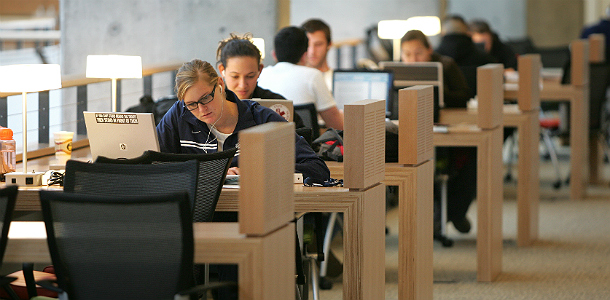
(Photo Credit: CSU, Monterey Bay)
The Budget Act of 2014 appropriates $50 million in one-time resources from the General Fund for the Awards for Innovation in Higher Education. Five campuses were awarded the maximum prize of $5 million each and CA Fwd will feature them in a weeklong series. California State University Monterey Bay, which also won a $3 million award for a math initiative which is also discussed in this interview with Bonnie D. Irwin, CSUMB Provost and Vice President for Academic Affairs.
CA Fwd: Briefly describe what your innovation was designed to do?
Bonnie Irwin: “CSU Monterey Bay (CSUMB) earned two awards, and both are designed to increase graduation rates, particularly in STEM disciplines, and reduce costs by shortening the time it takes to earn a degree. CSIT-in-3, our first tier winner, is also designed to address the lack of diversity in Silicon Valley. This program builds a collaborative pathway between Hartnell College and CSU, Monterey Bay, utilizing cross-enrollment, collaborative scheduling and registration processes and integrated academic success support to graduate traditionally underrepresented students with computer science degree in three years. High impact academic support services like peer-led team learning, review sessions, tutoring support and cohort enrichment were provided to the cohort. We focus both on academics and grit in the students. This attention to individual student needs and support is also a hallmark of our developmental math courses, which received a second-tier award.”
CA FWD: These innovations take partnerships–who did you work with and why was that important to its success?
Bonnie Irwin: “A key characteristic of the collaboration between CSUMB and Hartnell College has been both institutions’ ability to complement each other’s strengths. We also built partnerships with counselors and teachers at all 14 comprehensive high schools in Monterey County. It should be noted that funding support from Matsui Foundation, Monterey Peninsula Foundation and National Science Foundation helped start this pilot project. The program was further augmented by internships with individuals at Cisco, Facebook, Google, Thoughtworks, Language Line, Salesforce and Uber. Additional partners for our math initiative include high schools and middle schools in the region. Granite Rock and the Gates Foundations have provided financial support.”
CA Fwd: What did you learn?
Bonnie Irwin: “To be sure, we learned a lot about the administrative processes, academic alignment and course sequencing needed to implement cohort-based programs, benefits of high touch, integrated academic support, and the importance of outside class engagement of students in learning and professional growth. Most importantly, we have learned that a large majority of students are eager to work hard, rise up to challenges and demonstrate passion with perseverance when given the right motivation and guidance. We have learned that building cohort based programs that provide the right learning environment is the key to unlocking this potential.”
CA Fwd: What data and analytic(s) have you used to assess the impact of this work and have they helped?
Bonnie Irwin: “Metrics included attendance in class and enrichment activities, grade tracking throughout the semester, retention and internship placements. We also have collected qualitative data through surveys, focus groups, checkpoint content knowledge tests and feedback from industry partners based on their experience interviewing the students. Twice per year, all the data collected are reviewed and specific adaptations to the program policy, process and practices are developed.
For remedial math, we have looked at the success rate of the students and have tracked them beyond remediation as they move to subsequent classes in mathematics and to their other subjects to determine whether the foundation they have been given in the earliest class enables them to move successfully into higher math classes and other subjects requiring additional higher-order thinking. We have used the results to apply the strategies from this program to additional math courses.”
CA Fwd: How will you sustain the innovation that you were awarded for?
Bonnie Irwin: “Sustaining CSIT-in-3 requires multiple objectives: changing existing policies, practices and systems to support cohort based scheduling, registration and other administrative services; developing a cost model that takes a broad set of outcomes to determine the optimal way to implement high touch academic support and quality initiatives; development of adaptive pathways that allow proactive and seamless transition of students based on academic performance and life situations; K-12 outreach that ensures recruitment of well prepared students ready for the academic and workload challenges of accelerated degree programs; technology solutions that allows for tracking and alerts for students Through much of their educational career.
On the qualitative side for both our initiatives, faculty openness to new ways of thinking and teaching is key. We recruit faculty with these attitudes and expand the team. These hires will also enable us to share strategies with other programs, both on our campuses and others. Another component we seek to sustain and disseminate is cost savings for the state and students’ families.”
CA Fwd: What could the state do to make it easier to encourage innovation in higher education (and other parts of state government)?
Bonnie Irwin: “These awards go a long way toward encouraging innovation and rewarding it, which allows innovators to have an impact beyond their individual campuses. Expanding this sort of support to more than a one-time process would be helpful; having monies available that are tied to performance and not headcount would encourage innovation. Providing opportunities for further sharing of ideas is also key. Not all innovations are transferrable, but certain parts of them are, and giving others the opportunity to learn from our experience and us to learn from theirs will spread the influence. One key with our CSIT-in-3 program is having employers directly involved, working with our faculty meeting our students, giving feedback on our efforts. Similarly, providing educators space to talk across sectors with a goal of improving the whole cradle-to-career pathway will help everyone think in new ways about success.”

